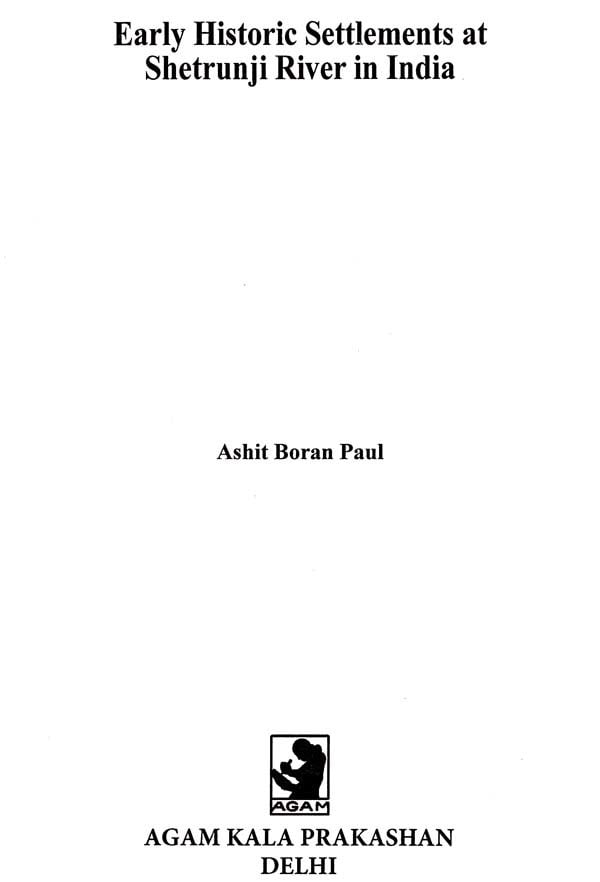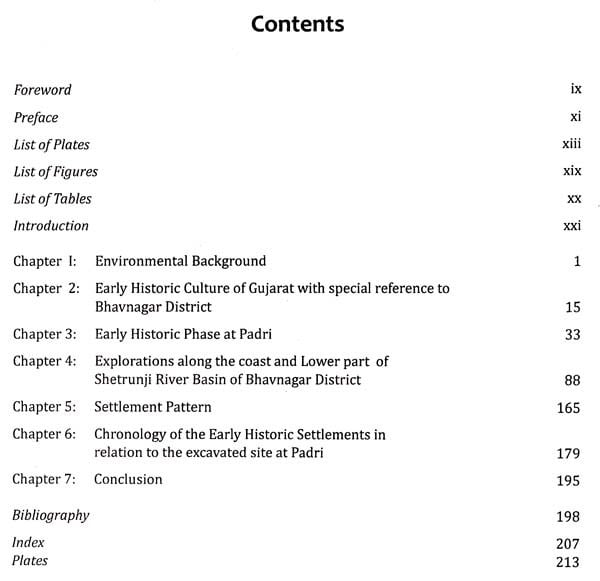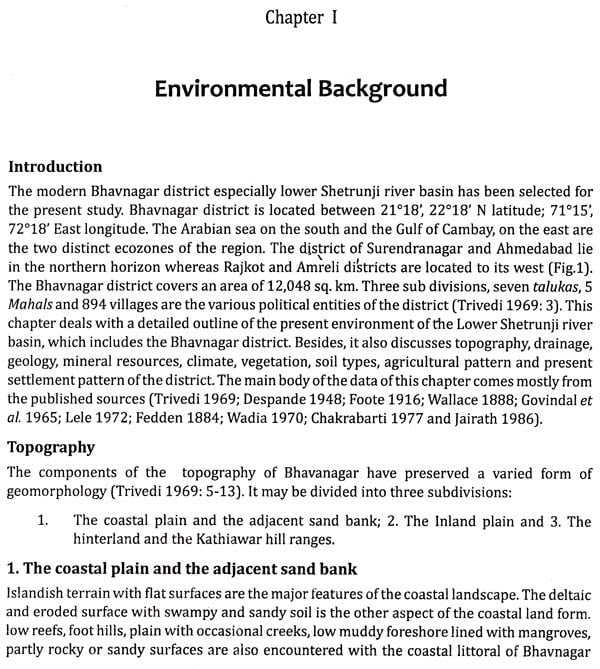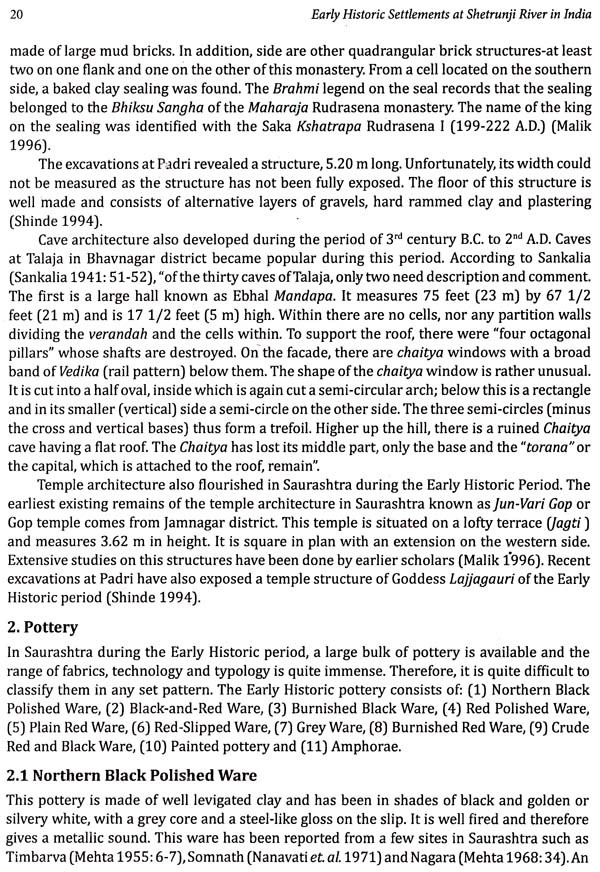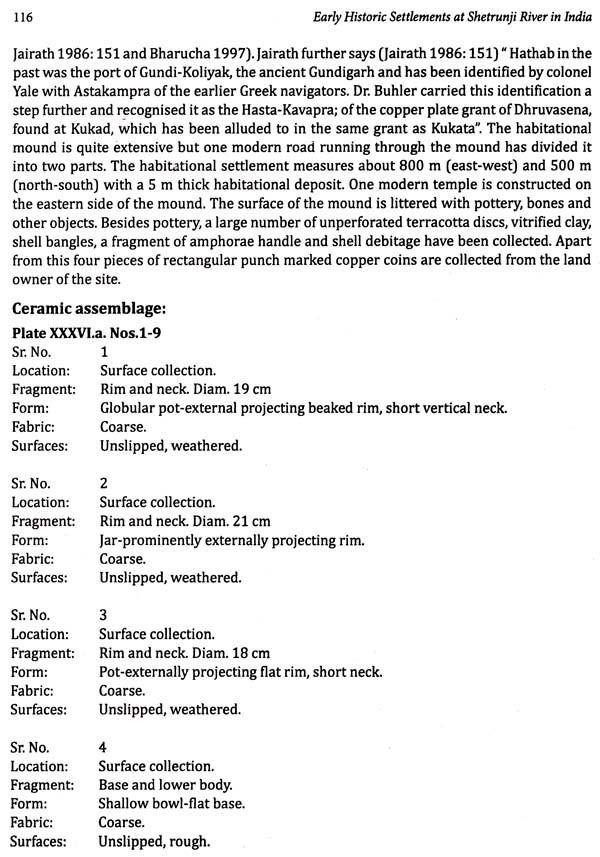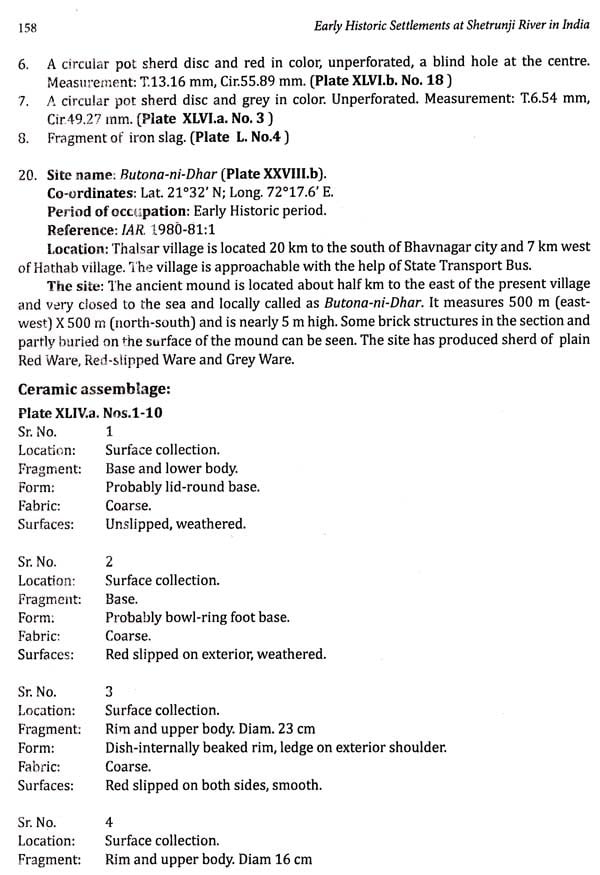
Early Historic Settlements at Shetrunji River in India
Book Specification
| Item Code: | AZH096 |
| Author: | Ashit Boran Paul |
| Publisher: | AGAM KALA PRAKASHAN, DELHI |
| Language: | English |
| Edition: | 2017 |
| ISBN: | 9788173201561 |
| Pages: | 266 (Throughout B/W Illustrations) |
| Cover: | Hardcover |
| Other Details | 11.00x9.00 inch |
| Weight | 990 gm |
Book Description
The book is the detailed study of the settlement archaeology of the lower Shetrunji river basin and coastal part of Bhavnagar district of Saurashtra in Gujarat during the Early Historic period. The Early Historic period of Gujarat in general and Saurashtra in particular was marked by a growth of large and small size towns such as Amreli, Akota and Valabhipur. The main theme of the present volume is the Early Historic settlements which were located in the lower part of the Shetrunji river basin, L.e. in and around Padri and Hathab. The archaeological importance of Bhavnagar district was established by the some Importance discoveries in the field of Prehistoric, Protohistoric and Early Historic archaeology. The Shetrunji river basin and coastal part of Bhavnagar district in Saurashtra played an important role during the Early Historic period (2 century B.C-2 century A.D) as is evident from the excavations at Padn, Talaja Taluka, Bhavnagar District, Saurashtra. The site of Padri is located in the lower Shetrunji river basin and systematically excavated by Prof. Vasant Shinde. The site has yielded three-fold cultural y sequence, Early Harappan (3000 B.C-2600 B.C.), Mature Harappan (2500 B.C-1900 B.C.) and Early Historic period (2 century B.C-2 century A.D.). However However, no systematic survey was undertaken in this area. An extensive survey was carried out by the present author along the coast and in the both sides of the lower part of Shetrunji river basin, Bhavnagar district in Gujarat on foot during the field seasons of 1996-98. A total numbers of twenty-two Early Historic as well as Harappan settlements were discovered in the course of explorations in this region. The book contains a detailed study of the development of settlement pattern in global perspectives. A detailed analysis of the pottery and other objects of the systematic excavated site of Padri are available in the book Besides, the book contains the material cultures of the newly discovered sites. The site has yielded quite a number of terracotta objects such as discs, human and animal figurines, wheels, ear studs, boat-shaped motifs, toy pots and a circular tablet with Brahmi inscription. This suggests that the peoples in this region knew several games and amused themselves in various ways. The tortoise shaped Roman copper lamp that has been found at the site shows contact with the Westem world in this region during the Early Historic Period. On the basis of occurrences of fishing hooks and others. agricultural implements at the site it is assumed that fishing and agricultural activities must have played an important role in their subsistence pattern. The important contribution of this work is that the data from the excavation at Padri was used for dating precisely the Early Historic sites in this region. Besides, an attempt has been made for the first time to study the pattern of Early Historic settlements, function of each settlement and interaction between the various settlements.
Ashit Boran Paul (b. 1964) did his Ph.D. under the guidance of Prof. Dr. Vasant Shinde, Vice chancellor, Deccan College Post-Graduate and Research University, Pune in 1999 on Early Historic settlements and archeology of Gujarat. At present he is working as Professor at the Department of Archaeology and Provost, Bishwakabi Rabindranath Tagore Hall, Jahangirnagar University, Savar, Dhaka, Bangladesh. He has been engaged in teaching and research for more than twenty four years. He was previously Dean, Faculty of Arts and Humanities, Provost, Al-Beruni Hall, Fajilatunnesa Hall, respectively. Jahangirnagar University. Besides, he served as Chairman (Head of the Department) in the department of archaeology, International Relations and founder chairman, the Department of Journalism and Media Studies of the same university. Dr. Paul was worked as principal consultant in the project of Young Hand Tools in Cultural Resource Management: Special Reference to Paharpur World Heritage Site in Bangladesh funded by UNESCO in 2008. He was also consultant for a project offered by the Education Ministry, Peoples Republic of Bangladesh and also Sub-Project Manager HEQEP, University Grants Commission, Bangladesh. Apart from this, he has conducted archaeological explorations in Bangladesh as well as in India. The author also participated in the excavations at Mahasthangarh, Bogra district, Raja Harishchandra Dhibi, Savar, Dhaka in Bangladesh as well as in Balathal, Udaipur district, Rajasthan, India. He is a member of many learned societies in Bangladesh. His area of specialization on Early Historic Archaeology in Bangladesh. He has produced more than 25 articles in and abroad. He has participated in various national and international seminars and also organized more the one international seminar.
I am extremely glad to write this Foreword for the book entitled Early Historic Settlements in Bhavnagar District with Special Reference to Padri. The Bhavnagar district was important right from the beginning of the early settled life going back to 4000 B.C. It has yielded a large number of Harappan sites some of which were studied in great detail. The elements and characteristic features of the Harappan culture in Bhavnagar district were properly identified during the course of excavation carried out at the site of Padri from 1990 to 1995. However, the cultures prior and after the Harappan period were not studied properly. This is, therefore, the first systematic effort in documenting Early Historic settlements in Bhavnagar district.
Dr. Paul undertook systematic village to village survey in the entire Bhavnagar district, discovered and studied more than 100 sites from the point of view of understanding the exact reasons for the locations for these sites. He studied the determinant factors for the establishment of these sites and arrived at the conclusion that the locations of most of the sites were governed by the arable land. The settlement pattern studies on Early Historic Culture is not carried out in great depth in India and therefore this work assumes greater significance. This can serve as a model for future researchers for planning to work on similar model. Efforts have also been made to categorize sites in different hierarchical levels and relationship between different sites from the point of view of trade and economy. In future some of the important Early Historic sites need to be subjected to site catchment analysis to understand the subsistence strategy and level of economy of this people. The research carried out by Dr. Paul have demonstrated that Bhavnagar district was an important region for the Early Historic people where they mostly subsisted on agriculture and carried out hinterland and international trade. Some of the sites located along the coast may have played important role in overseas trade of the Early Historic people. Dr. Paul was not able to identify the roles of some of these sites but this could be an important topic for future research. Some of the sites in this region have produced Roman and Iranian pottery indicating trade contacts with those regions. However, more research is required on this aspect. Overall, the research carried out by Dr. Paul is significant and has added new dimension to the Early Historic archaeology in India. I congratulate Dr. Paul for his immense contribution to the relevant field which might serve a model for the future researchers.
The present work is the revised version, which earned the author Ph.D. degree from the Deccan College Post Graduate and Research Institute, Pune in India in 1999, of the detailed study of the settlement archaeology in the lower Shetrunji river basin of Bhavnagar district in Gujarat. The Shetrunji river basin and coastal part of Bhavnagar district in Saurashtra played an important role during the Early Historic period (1" century B.C.-A.D.) as is evident from the excavations at Padri, Bhavnagar District, Saurashtra. An extensive survey was carried out on both sides of the lower part of Shetrunji river basin on foot during the field seasons of 1996-98. In all, twenty-two Early Historic sites have been studied along the coast and the lower part of Shetrunji river of which eight were already reported by the earlier scholars from the point of view of settlement pattern.
The author is express his deep sense of gratitude to Prof. Vasant Shinde, his research supervisor for his constant encouragement, guidance, extending maximum facilities and allowing him to use the excavated material of Padri. Without his help and valuable suggestions at various stages, it would not have been possible to bring this book to its present form. Besides, the author is also grateful to Prof. V. N. Misra, the then Director, and Prof. K. Paddayya of Deccan College who always encouraged him on various occasions.
Dr. Mahesh Bhai Pandya and his family of Padri village for their warm hospitality. It is because of their co-operation that the author could complete his field survey in the Shetrunji river valley in Bhavnagar district Gujarat. The Ford Foundation grant of Jahangirnagar University in Bangladesh extended substantial financial support for this work. The author is also grateful to his teacher Prof. Abu Imam who inspired him to study archaeology in Post Graduate level at Jahangirnagar University. The author also acknowledges his wife Pallabi and daughter Dipanwita who were with him at Deccan College while completing this work.
The Shetrunji river basin and coastal part of Bhavnagar district in Saurashtra played an important role during the Early Historic period (1" century B.C.-A.D.) as is evident from the excavations at Padri, Talaja taluka of Bhavnagar District, Saurashtra (Shinde 1992a, Paul 2000). However, this region was not surveyed systematically for antiquarian remains. To understand the Early Historic archaeology and its settlement pattern, the lower Shetrunji river basin and coastal areas of this region were selected for a detailed study.
The area of present study is the lower part of Shetrunji river basin ie. in and around Padri and Hathab in the Bhavnagar District of Saurashtra, Gujarat.This river is the second largest river of Saurashtra, has a total length of about 180 km of which about 92 km of its course is through the district (Trivedi 1969). Thus the total area under study is around 1000 sq. km. The sites of Padri (Ghosh 1989: 206; IAR.1972-73) and Hathab (Schoff 1912: 39 40; IAR 1980-81) have been treated as index sites. The region around these sites has been thoroughly investigated. Padri is located in the lower part of Shetrunji river basin which was systematically excavated (Shinde 1992a; 1992b; 1992c; 1994a; 1994b; 1996 and 1998). The Early Historic phase is confined to the upper three layers. The other site at Hathab, 23 km east of Bhavnagar town, is located on the Gulf of Cambay. It represents ancient Hastavapra or Hastakavapra (Trivedi 1969), which was rendered as Astacampra in the Greek literature (Schoff 1912: 39-40). The site may have played an important role in the socio-economic organization of the Early Historic period.
The archaeological potential and importance of Bhavnagar district was established by some important discoveries in the field of Prehistoric, Harappan and Chalcolithic culture. Prehistoric research in Saurashtra began as early as 1884, when Fedden investigated the geological features of the Peninsula belonging to the later part of the Trappean and sub recent times (cited from Chakrabarti 1977: 10; Jairath 1986: 1). On the other hand it was Bruce Foote (Foote 1916: 146-155) who was amongst the first persons to collect Palaeoliths in India and carried out an exploration in some parts of Peninsular India and report his finds as "Neolithic and pottery of later date" in early part of the twentieth century. Since then, Saurashtra has received much attention by archaeologists. In the early fifties R. N. & hta discovered early Palaeolithic artifacts for the first time from the Amreli district in Saurashtra (Jairath 1986: 1). In 1962 Sankalia (Sankalia 1965: 327-340) discovered Early and Middle Palaeolithic artifacts from the stratified deposits in the river valley of Bhadar. In the late seventies Sundarrajan (IAR.1967: 86) brought to light some Early Palaeolithic implements in the Sherdi Valley in Junagadh district of Saurashtra. After wards, Lele (Lele 1972) discovered a good number of Early Palaeolithic sites in the Bhadar river valley. Similarly, the evidences of Middle Palaeolithic artifacts were collected from various parts of Peninsular India by Pandya in 1952, Rao in 1959, Lele in 1970-71, Marathe in 1975 (cited from Chakrabarti 1977: 12). Apart from this, in late eighties Chakrabarti (1977) discovered many Early and Middle Palaeolithic sites in the Kalubhar valley. Besides, Possehl (1980), Suman Pandya (1973) and Jairath (1986) brought to light some Palaeolithic sites in Bhavnagar district.
The research on Harappan culture started in 1930, in Gujarat in general and in Saurashtra in particular. It was Father H. Heras of Bombay who first carried out an excavation at the vicinity of Valabhipur, Bhavnagar district in Saurashtra in 1930's. The excavations have yielded few objects like knob-pot, knob-jar-covers and terracotta calf. However to the excavator these materials belong to the Mohenjo-Daro-Harappan period (Heras 1938; 1990: 56). In 1935 M.S. Vats of the Archaeological Survey of India had conducted an excavations at Rangpur in Limbdi Taluka of Surendranagar district in Saurashtra. On the basis of his findings from the excavations, Vats assigned these to correspond with the late period of the Indus Valley sites (Vats 1936: 38). Since then, Rangpur was subjected to excavations which were successively undertaken by Ghurye in 1937, Sankalia and Dikshit in 1950 and Rao 1953-56 (Pandya 1973: 82).
**Contents and Sample Pages**
